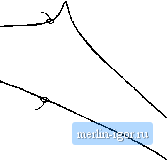
 | |
|
Строительный блокнот Introduction to electronics 40 dB II Gil 20 dB OdB -20 dB OdB 60 dB
ЮОНг 1 кНг 10 Шг 100 кНг ilg. Н.26 Comparison of CPM tonfml with duty-cycle t ntrol, for tlie contiyjl-to-output frequency lesponse of the buck converter exunijile. control input equal to V. - 1.4 V, At the quiescent tiperating point, the switch duty cycle is £> = 0.676, the dc output voltage is V= 8.1 V, and the dc component of the inductor current is Ц = 0.81 A, The converter operates in CCM. Magnitude and phase re.sponses of the control-to-output transfer functions G.(.s) = WC. and СД*) - vidare shown in Fig. B.26. The duty-cycle to output voltage transferfunction G./.t) exhibits the familiar second-order high-Q resptmse. Peaking in the magnitude response and a steep change in phase from 0° to - 180° occur around the center frequency of the pair of complex-conjugate ptdes. In contrast, the CPM control-to-output respoii.se has a dominant low-frequency pole, The phase lag is around - 90° in a wide range of frequencies. A high frequency pole contributes to additional pha.se lag at higher frequencies. The frequency responses of Fig. B.26 illustrate an advantage of CPM control over duty-cycle control. Because of the control-to-output frequency response dtimiiiated by the single lt)w-freqnency pole, it can be much easier to close a wide-bandwidth outer voltage feedback loop around the CPM contrt)lled power converter than around a converter where the duty cycle is the control input. .Another advantage of CPM control is in rejection of input voltage disturbances. Line-to-output frequency responses for duty-cycle control and CPM control in the buck example are compared in Fig. B.27. At practically all frequencies of interest, CPM control offers more than 30 dB better attenuation of input voltage disturbtuices. It is also interesting to compare the output impedance of the ctinverter with duty-cycle control versus CPM control. The results are shown m Fig. B.28. At low frequencies, duty-cycle controlled converter has very low output impedance determined by switch and inductor resistances. As the frequency goes up, the output impedance increases as the impedance of the inductor increases. At the resonant frequency of the output LC filter, significant peaking in the output impedance of the duty-cycle controlled convetter can be t>bserved. At higher frequencies, the output impedance is dominated by the impedance of the filter capacitor, which decreases with frequency. In the CPM controlled converter, the low-frequency impedance is high. It is equal to the parallel combination of the load resistance and the CPM cut- I G, II 20 dB -20 dB 40 dB -60 dB -80 dB -tOOdB Dttty cycle control d{i) = ronsiani Currem programmed mode vU) = constant  10 Hi 100 Нг 1 kHz 10 kHz 100 кНг Fig. B.27 Comparison of CPM control with duiy-ccle ctniirol, for the line-to-output frequency response of the buck converter csample, 20 dBQ OdBQ -20 dBQ Current programmed mode vjt) - constant Duty cycle control d{t) = constant  ШНг 100 Hz IkHz SO kHz 100 kHz Fig. B.28 Comparison of CPM control with duty-cycle control, for the outpat impedance of the huck converter example. put resistance. Because ofthe lossless damping introduced by CPM control, the series inductor does not affect the output impedance, As the frequency goes up, the output impedance becomes dominated by the output filter capacitor and it decreases with frequency. At high frequencies the output impedances ofthe duty-cycle and CPM controlled converters have the same asymptotes. Referexces [I] R. j. DlRKMAN, The Simulation of General Circuits Containing Ideal Switches, IEEE Power Electronics Specialists Conference, lJS7 Record, pp. lS5-iy4. [2] C. J. Hsiao, R. B. Ridley. H NAiTt)ii and F. С Lee. Circuh-Oriented Discrete-Time Modeling and Sim- ulation of SwicchJDg Converters, IEEE Power Electronics Specialists Conference. I9S7 record, pp. 167-176, [3] R. C. Wong, H. A. Owen, T. O. Wilson, Ad Efficient Algorithm for the Time-Domain Simulation of Regulated Energy-Storage DC-to-DC Converters, IEEE Transactions on Power Elearonics, Vol. 2, No. 2, April 19K7, pp. 154-I6H. [4] A. M. Luciano and A. G. M. Strollo, A Fast Time-Domain Algorithm for Simulation of Switching Power Convertei-s, IEEE Transactions on Power Electronics. Vol. 2, No. 3, Jidy 1У9(), pp. 363-37Q. [5] D, Bedrosias and j, Vl.cii, Time-Domaiii .Analysis of Networks with liiternally Controlled Switches, IEEE Tran.tactions on Circuits and Systems-I: Fundamentai Theoiy and Applications. Vol. 39, No.3, March ml. pp. 199-212. [6] I . PEJOVtC and D. MAKSlMOVlt, A New Algorithm for Simulation of Power Electronic Systems Using Piecewise-Linear Device Models, IEEE Transactions on Power Electronics, Vol. 10, No. 3, May 1945, pp. 34()-34К. [7] PlitlUKAtl PEJOVIc, A Method for Simulation of Power Electronic Systems Using Piecewise-Linear Device Models, Ph.D thesi.4. University of Colorado, Boulder, April 1У95. [8] D. Lt, R. TYMERSKt, T. NtNOMiYA, PECS-An Eftlcacious Solution for Simulating Switched Networks with Nonlinear Elemenis, IEEE Power Electronics Specialists Conference, 2000 Record, pp. 274-279, June 2aX). [9] V. bello, Computer Aided Analysis of Switching Regulators Using SPICES, IEEE Power Electronics Specialists Conference, I9SQ Record, pp. 3-11. [10] V. bello, Using the SP1CE2 CAD Package for Easy Simulation of Swilching Regulators in Bolh Continuous and DiscoDtinnous Conduclion Modes, Proceedings of the Eighth National Solid-State Power Conversion Conference (Powercon S), April 19SI. [II] V. BELLO, Using the SP1CE2 CAD Package lo Simulate and Design lhe Current Mode Converter, Proceedings of the Eleventh National Solid-Siate Power Cum-ersion Conference (Powercon 11), April 19S4, [12] d. KlHilL S Ben-Yaakov, .a SPICE Model for Cuirent Mode PWM Converters Operating Under Con-liiiuou.4 Inductor Currenl Conditions, IEEE Transactions on Power Eiectronics, Vol. 6, No. 2, April 19У1, pp. 2K1-2K6. [13] Y. Amrak, F. HuLiEiiEL, S. Ben-Yaakov, A Unified SPICH Compatible Average Model of PWM Converters, IEEE Tran.wctions on Power Electronics. Vol. 6, No. 4, October 1У91, pp. 5S5-594. [14] S. BEN-Yaakov, Z. Gaaton, Generic SPICE Compatible Model of Currenl Feedback in Switch Mode Converters, Electronics Letters. Vol. 2S, No. 14, 2nd July lm. [15] S. Bes-Yaakov, Average Simulation of PWM Converlers by Direct Implementation of Behavioral Rela- |